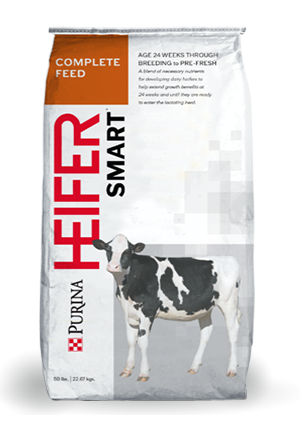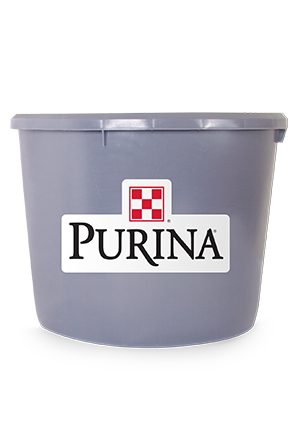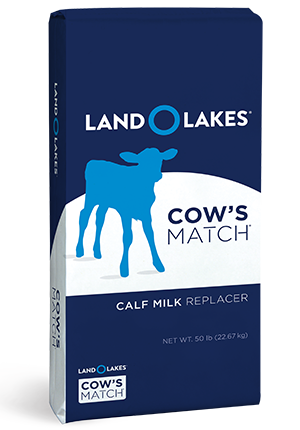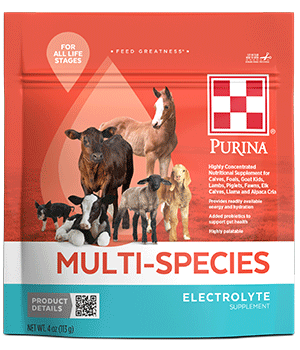
Dairy Calf Nutrition Without Compromise
Calf : Calf Management
Heifer : Heifer Management

Dairy farm budgets currently are seeing some lean times, but Cricket (James) Jacquier is not willing to put his replacement heifers on a diet to match those circumstances.
Jacquier is co-owner of Laurelbrook Farm, a 1,100-cow enterprise near East Canaan, Ct. The farm is owned and managed by Jacquier; his father, Peter; and his brother, Bobby. The third-generation dairyman also is raising a fourth with his wife, Jennifer: daughter, Morgan, and son, Colby are involved in day-to-day operations on the dairy, along with Bobby’s children, Austin, Dalton, Shelby, Bailey and Kayla.
Through the ups and downs of milk and feed prices – and there have been many over the years – the family largely attributes their ability to stay the course and profitably grow the dairy herd to their investment in, and commitment to, properly rearing their young stock.
That’s why the Jacquiers are committed to following a complete young-stock nutrition program that takes a three-step approach to delivering nutrients to maximizing their heifers’ potential. It starts with a full-performance milk diet based on milk replacer, in conjunction with a high-protein starter feed. The third phase is a grower ration that contains the same flavors as the milk replacer and starter, for consistent palatability and intake. Specifically, the program includes:
1. Milk replacer, fed at 1 pound of dry matter (DM) mixed with 3 quarts of water, fed 3 times per day (after the first week of life), for a total of 3 pounds DM per day. To accommodate the effects of dramatic climate swings in the Northeast, they feed a warm-weather formulation from approximately April through September, and a cold-weather formulation of the same brand the other half of the year. Calves are weaned at 56 days of age.
2. Starter grain, introduced the second day of life. The 22% protein, texturized starter is fed free-choice for at least the first 12 weeks of life. The starter formula changes seasonally to accommodate seasonal changes as well.
3. Grower feed, containing 18% protein and the same flavors and immune-supporting technologies as the milk replacer and starter grain. The grower ration is fed free-choice starting at 13 weeks, until heifers are consuming 10 pounds per day. Free-choice hay is added at 3-1/2 to 4 months of age, a few weeks after switching to the grower ration. The grower feed is continued at 10 pounds per head per day until 5 months of age, when heifers are switched to a TMR. A top-dress of the grower pellets is continued until they are eating the TMR well.
Jacquier added that clean, fresh, free-choice water also is critical to the program’s success. “Even the smallest calves need supplemental water, in addition to their milk replacer, to process nutrients and grow rumen and body capacity,” he said. “It’s a challenge in the winter, but definitely worth the extra time and labor.”
The farm currently uses a combination of calf hutches and indoor housing for preweaned calves. Both facility styles are managed for all-in, all-out stocking. That’s a given with hutches, which also promote excellent air quality, but are much more labor-intensive and don’t allow for grouping. Indoor housing is easier on workers, and Jacquier likes the gradual social adaptions they allow. Panels between individual pens are pulled when calves are 1 month old to create pair pens; 2 weeks later another panel is pulled to create groups of 3.
“There are advantages and disadvantages to both systems,” said Jacquier. “I’m still searching for the ‘perfect’ calf facility that provides both labor efficiency and outstanding air quality, plus affords the social adaptations that calves need.”
In addition, they go the extra step of measuring average daily volume gain (ADVG), which is calculated using growth factors for heart girth, body length and height. Currently, the ADVG from birth to weaning at Laurelbrook Farm is 3.03 liters. Jacquier believes volume gain is a huge contributing factor to 20% or more of their first-calf heifers reaching production levels of more than 100 pounds of milk per day. It also allows the Jacquiers to hit their breeding target of calving every heifer near 23 months of age.
“By keeping heifers healthy and feeding them for maximum growth and immunity, we are able to capture their genetic potential and create the large-capacity, aggressive eaters that can really make milk,” said Jacquier. “Now that we have a replacement-rearing program that works, I am reluctant to make any nutritional changes that might interrupt that momentum.”
Can’t get enough? Ready more about dairy calf nutrition here.
Jacquier is co-owner of Laurelbrook Farm, a 1,100-cow enterprise near East Canaan, Ct. The farm is owned and managed by Jacquier; his father, Peter; and his brother, Bobby. The third-generation dairyman also is raising a fourth with his wife, Jennifer: daughter, Morgan, and son, Colby are involved in day-to-day operations on the dairy, along with Bobby’s children, Austin, Dalton, Shelby, Bailey and Kayla.
Through the ups and downs of milk and feed prices – and there have been many over the years – the family largely attributes their ability to stay the course and profitably grow the dairy herd to their investment in, and commitment to, properly rearing their young stock.
A consistent nutrition approach
“One of the easiest things to do to save money in the short term would be to pull some of the protein out of our heifer ration,” Jacquier said. “But months down the road, we would have a group of two-year-olds that we would not be very excited about freshening. When milk prices come back up, we want to be ready to fully reap the rewards, equipped with an entire herd of strong, well-grown, high-producing animals.”That’s why the Jacquiers are committed to following a complete young-stock nutrition program that takes a three-step approach to delivering nutrients to maximizing their heifers’ potential. It starts with a full-performance milk diet based on milk replacer, in conjunction with a high-protein starter feed. The third phase is a grower ration that contains the same flavors as the milk replacer and starter, for consistent palatability and intake. Specifically, the program includes:
1. Milk replacer, fed at 1 pound of dry matter (DM) mixed with 3 quarts of water, fed 3 times per day (after the first week of life), for a total of 3 pounds DM per day. To accommodate the effects of dramatic climate swings in the Northeast, they feed a warm-weather formulation from approximately April through September, and a cold-weather formulation of the same brand the other half of the year. Calves are weaned at 56 days of age.
2. Starter grain, introduced the second day of life. The 22% protein, texturized starter is fed free-choice for at least the first 12 weeks of life. The starter formula changes seasonally to accommodate seasonal changes as well.
3. Grower feed, containing 18% protein and the same flavors and immune-supporting technologies as the milk replacer and starter grain. The grower ration is fed free-choice starting at 13 weeks, until heifers are consuming 10 pounds per day. Free-choice hay is added at 3-1/2 to 4 months of age, a few weeks after switching to the grower ration. The grower feed is continued at 10 pounds per head per day until 5 months of age, when heifers are switched to a TMR. A top-dress of the grower pellets is continued until they are eating the TMR well.
Jacquier added that clean, fresh, free-choice water also is critical to the program’s success. “Even the smallest calves need supplemental water, in addition to their milk replacer, to process nutrients and grow rumen and body capacity,” he said. “It’s a challenge in the winter, but definitely worth the extra time and labor.”
Heifer housing matters, too
In addition to nutrition, Laurelbrook Farm places heavy emphasis on giving every heifer the resting and breathing space she needs. “Nothing sets a heifer back, potentially for her entire life, like a case of respiratory disease,” said Jacquier. “Our nutrient-dense feeding program means they do create more waste, so we have to stay on top of air quality. We do everything in our power to keep those lungs healthy.”The farm currently uses a combination of calf hutches and indoor housing for preweaned calves. Both facility styles are managed for all-in, all-out stocking. That’s a given with hutches, which also promote excellent air quality, but are much more labor-intensive and don’t allow for grouping. Indoor housing is easier on workers, and Jacquier likes the gradual social adaptions they allow. Panels between individual pens are pulled when calves are 1 month old to create pair pens; 2 weeks later another panel is pulled to create groups of 3.
“There are advantages and disadvantages to both systems,” said Jacquier. “I’m still searching for the ‘perfect’ calf facility that provides both labor efficiency and outstanding air quality, plus affords the social adaptations that calves need.”
Measuring capacity, not just weight
The Jacquiers’ careful attention to replacement rearing includes monitoring results. Impressively, calves more than double their birth weight and gain more than 4 inches of stature by weaning.In addition, they go the extra step of measuring average daily volume gain (ADVG), which is calculated using growth factors for heart girth, body length and height. Currently, the ADVG from birth to weaning at Laurelbrook Farm is 3.03 liters. Jacquier believes volume gain is a huge contributing factor to 20% or more of their first-calf heifers reaching production levels of more than 100 pounds of milk per day. It also allows the Jacquiers to hit their breeding target of calving every heifer near 23 months of age.
“By keeping heifers healthy and feeding them for maximum growth and immunity, we are able to capture their genetic potential and create the large-capacity, aggressive eaters that can really make milk,” said Jacquier. “Now that we have a replacement-rearing program that works, I am reluctant to make any nutritional changes that might interrupt that momentum.”
Can’t get enough? Ready more about dairy calf nutrition here.




